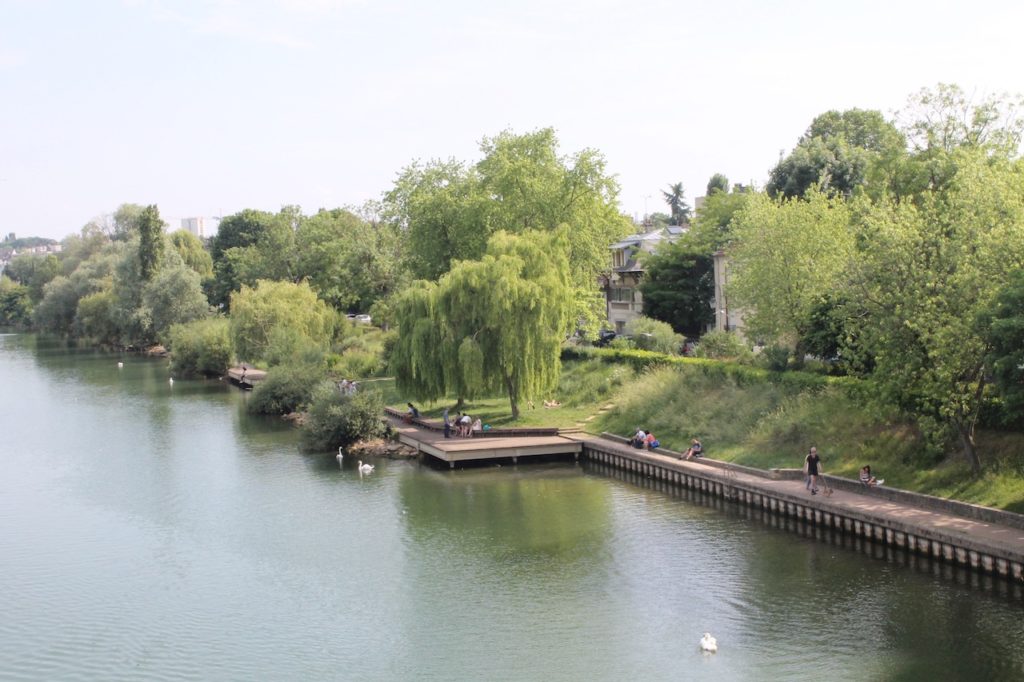
Architect
BASE landscape designer mandatory + Champalbert
Type of Area
Medium-sized river with artificial banks
Land/water interaction
Boardwalk
Vegetated bank
Decking
Built Environment Types
Moderately built
Moderate green
Scale of Impact
Block
District/Neighbourhood
City
Intervention Scale (Spatial)
Linear development – multiple interventions
Project Types
Riverfront development
Public space regeneration
Outdoor recreation
Urban/ Rural
Sub-urban area
Visibility and Openness
Fully enclosed
Fully contained view
Bringing people back to the river.
The city of Perreux-sur-Marne has re-established the relationship to its river, considering it as one of the main features of the city’s attention in terms of improving its environmental qualities to tackle, while combining that with the desire of the community to bring locals and visitors back to the banks of the Marne. The project, initiated by the city, was planned and built by BASE landscape designers + Champalbert hydrologic engineering in 2013. It was designed with an extended boardwalk to allow different uses and crossings on a quite limited site. It is connected by a sequence of meeting places equipped with pontoons and benches along the Marne and includes a playful garden in the centre.
Initially a holiday resort, Perreux became a mid-size city at the beginning of the 20th century, welcoming crowds of day-trippers from Paris to appreciate the bucolic setting of the banks of the Marne. Up to the eighteenth century, small houses were built on the slope of the undeveloped banks. Only a few laundry boats, public baths or fishing pontoons were installed, but the channelling of the watercourse to facilitate trade traffic led to the conversion of the riverbanks to hard surfaces.
The new appearance of the place was reinforced by emphasising the bucolic setting of the riverbanks. The design thus incorporated the atmosphere of a grove. Due to the almost village-like character of the neighbouring settlement, accessibility was enhanced for pedestrians and light traffic. The pathway is not immediately noticed when entering the area and materials used fit the ambience of the surrounding. This approach also allows a layering of the vegetation by combining contemporary urban planting practices with sustainable water ecology.
The project has brought back the people, flora and fauna to the banks of the river. The water and urban edges have been softened by converting former concrete flood defences into vegetated engineered slopes. This has been achieved by removing the masonry blocks and accepting seasonal flooding to widen the variety of different environments. People are attracted to the water when the riverbanks become accessible especially when new aquatic and terrestrial plants, different surfaces, lighting and furniture were added to allow people to spend time near the water. The types of seating provided are made of wood and constructed for different user needs; it offers an out-door gym and children play areas and can be accessed from the river by the jetty.
Perception and Meaning
Accessibility
Place identity
Sense of ownership
Health and Wellbeing
Place affordance
Increased physical activities
Place affordance
Interaction with Water
Visual

Website of the project:
https://www.baseland.fr/projets/le-perreux-sur-marne-berge-du-quai-dartois/ [French]
Google map reference
The accessibility of this site as a recreation area was improved by the rediscovery of the Marne riverbank to provide a promenade. The design quality is good although it performs lower for cultural heritage aspects, due to the fact that there is not much historical material to consider, just a symbolic connection.
Facilities are quite well provided although the site is exposed to wind and lacks shade in places. For health and well-being, it shows weakness in the sense of being away, due to the very built-up environment. Thus, it supports health and well-being benefits for local inhabitants, allowing people to embrace the beauty of this environment.
Water connections are generally good apart from direct access into the water or water activities as well as lacking safety equipment. Children’s play is very well provided for, but the range of possible water sports activities is somehow limited by the given terrain and nature of the design. A good project making excellent use of limited space in a peri-urban context.
